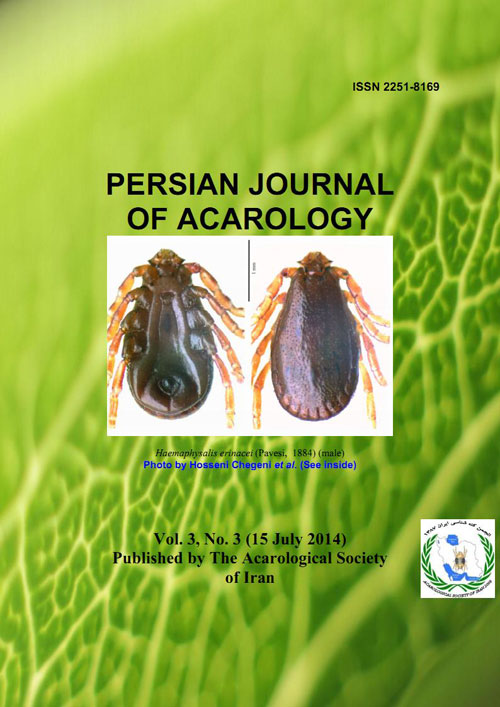فهرست مطالب

Persian Journal of Acarology
Volume:3 Issue: 3, Summer 2014
- تاریخ انتشار: 1393/07/10
- تعداد عناوین: 7
-
-
Page 171An oribatid mite of the family Oppiidae, Moritzoppia (Moritzoppia) unicarinata unicarinata (Paoli, 1908) is redescribed on the basis of Iranian material.Keywords: oribatid mites, Pycnonota, Oppiellinae, morphology, taxonomy
-
Page 177A new species of Eustigmaeus, E. caspianensis Bagheri & Paktinat Saeej sp. nov., is described based on females collected from soil, humus and moss in the Mazandaran and Golestan provinces, Iran.Keywords: Acari, Raphignathoidea, predatory mites, soil
-
Page 187Raphignathoid mites are important biological control agents of spider and eriophyid mites, and scale insects in agriculture and forestry. Therefore, a study on the fauna of superfamily Raphignathoidea in Zanjan city was carried out during 20122013. In this survey, 23 species belonging to 8 genera from 4 different families were collected and identified. Among them male of Stigmaeus shabestariensis Haddad Irani-Nejad, Lotfollahi & Akbari, 2010 was recorded for the first time from Zanjan, Iran and was new report to Acari fauna of the world, and also S. shabestariensis Haddad Irani-Nejad Haddad Irani-Nejad, Lotfollahi & Akbari, 2010 was the abundant mite species in Zanjan vicinities in our collected specimens.Keywords: Spider mites, Camerobiidae, Raphignathidae, Eupallopsellidae, Caligonellidae, Stigmaeidae
-
Page 203Ticks of the order Ixodida are among the most proficient ectoparasites worldwide. Haemaphysalis is the second largest genus within Ixodidae. Southeast Asia is thought to be the original center of development and dispersal of the genus. Six species of Haemaphysalis, H. concinna, H. erinacei, H. inermis, H. parva, H. punctata and H. sulcata, have been recorded as occurring in Iran. The current paper deals with notes on taxonomy of H. erinacei and provides a provisional key for the identification of Haemaphysalis species that occur in Iran.Keywords: Taxonomy, species, identification, pictorial key, tick
-
Page 217The antixenosis effects of Galia, CMD-158, CMC-132, CMI-157, CMI-167, CMI-175, Ananasi, Yellow Canary, Samsoori, Honey Dew, Bargney, CM-170, Khaghani and Garmsari, and the life table parameters of T. turkestani on CMC-132, CMI-167, Ananasi, Samsoori, Honey Dew and Bargney, were examined at 28 ± 1°C, 65 ± 10 % RH and a photoperiod of 16:8 L:D. In free-choice assay, the lowest preferences by adults were observed on CMI-167, Samsoori and Ananasi opposed to Honey Dew and Bargney were preferred the highest by adults of T. turkestani. The longest developmental times for both sexes were observed on CMC-132 and Ananasi, while the shortest developmental times were obtained on Honey Dew, Samsoori for females. The lowest total fecundity was observed on CMC-132 whereas the maximum was on Honey Dew. In addition, the highest value of intrinsic rate of increase (rm), net reproductive rate (R0), finite rate of increase (l) of T. turkestani were observed on the Honey Dew. The Weibull and Enkegaard models were used to fit survivorship (lx) and age specific fecundity (mx) data, respectively. The comparison and cluster analysis of biological parameters of T. turkestani on different melon genotypes demonstrated that CMC-132, Ananasi and CMI-167 were the most resistant genotypes to this pest.Keywords: intrinsic rate of increase, life history, reproduction, plant resistance, host plant


